Some cool insight into our Swim of the Week: after we recognized Missouri State’s Artur Osvath for his school-record 200 breast, Missouri State associate head coach Chelsea Dirks-Ham reached out with a specific set he used in his preparation that week.
A big thanks to Dirks-Ham and the Missouri State program for sharing this bit of coaching intel. The set pairs some “buckets” (resistance-based swimming attached to a bucket of weight, sometimes known as “Power Towers” or “Pulleys”) with 50s at 200 pace. You can see it below in Dirks-Ham’s tweet, or reproduced below that:
This is one of my favorite sets to have Artie do during his taper. He always responds well to the resistance of the buckets going into the pace 50’s with a strong stroke count. His ability to hold smooth 28’s gave us a lot of confidence for his race! pic.twitter.com/TZzwdmFk0e
— Chelsea Dirks-Ham (@c_dirks_ham) January 30, 2019
4 rounds:
2 x 15-meter breaststroke kick with board, attached to the bucket
2 x breaststroke pullout plus 4 strong stroke cycles, attached to the bucket
1 x 50 breaststroke at 200 pace from a push
1 x 50 easy
Dirks-Ham also kept track of Osvath’s times and stroke counts on the pace portion of the set: he roughly held 28-mid-to-lows (between 28.1 and 28.6), taking 4 strokes on the opening 25 and either 4 or 5 strokes on the second 25. Top-tier 200 breaststrokers really seem to excel with low stroke counts, and sure enough, Osvath’s stroke counts during his 1:53 race three days later were 3, 4, 4, 4, 5, 5, 5, 6. His pace 50s most closely mirrored the second 50 of his 200, which was 28.6. The final two 50s were 29.3 and 30.0.
While not every coach will have access to buckets (or the ability to run a set like this with a larger group), the effect could be roughly replicated with parachutes, stretch cords or even a drag suit.

This is great. I was a short-axis swimmer (fly), and resistance was one of the most effective training tools I used. In short axis, every stroke you accelerate quickly with the stroke/kick, and decelerate on the recovery. When something is constantly pulling you back, you REALLY feel the deceleration and maybe even start moving backwards during that time. That helped my body learn the best muscle memory, positioning, and tempo to minimize that deceleration.
Through the course of a season, I started with 20 x 15 yards (that’s how long the tower’s cord was) @ 30 seconds, and worked down to 8 x 15 yards @ 60 seconds. All out – taking as many kicks as in a real… Read more »
I wonder how different his time would be if he didn’t do 4 dolphin kicks off each wall haha!